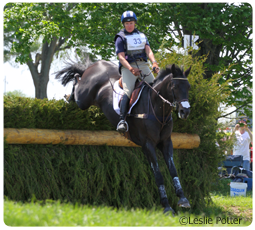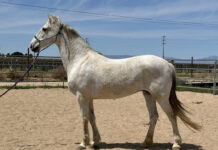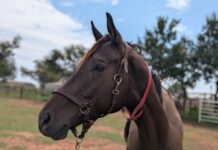 Just as meticulous maintenance keeps a high-performance racecar running at top speed, equine athletes need their own “pit crew” to stay sound and healthy. The smart owner takes a proactive approach and works closely with her veterinarian, farrier and trainer to keep her horse sound and healthy. Other professionals, such as equine nutritionists, chiropractors and acupuncturists can also be part of the performance horse’s team.
Just as meticulous maintenance keeps a high-performance racecar running at top speed, equine athletes need their own “pit crew” to stay sound and healthy. The smart owner takes a proactive approach and works closely with her veterinarian, farrier and trainer to keep her horse sound and healthy. Other professionals, such as equine nutritionists, chiropractors and acupuncturists can also be part of the performance horse’s team.
“These athletes should be fed a high quality forage and concentrate,” notes Armon Blair, DVM, a veterinarian with Ocala Equine Hospital in Ocala, Florida. “There are many makers of quality feeds. You get what you pay for in a feed so don’t cut corners here.”
Chose a quality commercial concentrate designed for your horse’s age, use and amount of work. Many manufacturers make concentrates that are high in fat and low in starch, which is easier on the horse’s digestive system.
While performance horses generally require more concentrate than horses that don’t work as hard, the foundation of any horse’s ration should still be forage. Concentrate will help meet the additional needs of the hard-working athlete, but that horse still needs some type of long-stem forage (hay, pasture or a combination of both) as the bulk of his food intake in order to maintain normal digestive function. Depending on his size and workload, a performance horse may eat anywhere from 1% to 2% of his body weight in forage each day—that’s 10 to 20 pounds for a 1,000-pound horse.
Owners often add supplements to a performance horse’s ration. Popular ingredients include glucosamine hydrochloride, chondroitin sulfate, a variety of herbs, omega-3 fatty acids and rare earth minerals, which contain one or more rare earth elements, including valuable trace minerals.
Because a majority of performance horses have been shown to have stomach ulcers, many owners rely on products made to protect the stomach, especially during times of stress, such as travel, change of environment, training and competition. You should talk with your veterinarian about an appropriate prevention/treatment plan for ulcers.
While it can be expensive to maintain a horse competing at the highest levels, careful attention to detail can prevent injury, which can take a horse out of training and competition.
Don’t underestimate the necessity of proper hoof care. Whether a horse is shod or barefoot, if his feet are not balanced, he will land unevenly and this can cause stress and abnormal concussion on his joints.
“This is extremely important; a balanced foot is critical,” notes Dr. Blair. “Many lamenesses originate in the foot and this is even more important in high-level athletes.”
In the barn of top American eventers David and Karen O’Connor, there is a standing appointment with the veterinarian and blacksmith every Tuesday. Each horse is trotted and examined to identify any wear-and-tear of soft tissue before it affects joints and bones.
Many performance horses receive additional therapies such as hydrotherapy, massage, acupuncture, magnetic therapy and herbal medicine.
“These modalities can be useful as part of the overall plan for maintenance of athletes,” notes Dr. Blair.
“It’s up to us to stay on top of the latest technology, holistic medicine and all the different types of therapy that give the horse the chance to be his best,” adds Karen O’Connor.
Performance horses often have heavy competition schedules, which require traveling. Because these horses are exposed to other horses and different environments, it’s important to maintain a vaccination schedule that will provide optimal protection. Your veterinarian will tell you which specific vaccinations your horse needs.
“Staying current on vaccines and deworming keeps the body in prime condition and prevents lost training time due to illness,” says Dr. Blair.
When it comes to exercising the performance horse, it’s easy to focus on your specific discipline. In fact, that’s what you should do, right? Not necessarily. Dr. Blair finds that, while horses certainly need exercise to get in condition and stay fit, it’s common for riders to over-train, but not cross-train.
A training program designed for only one discipline can increase the rate of musculoskeletal injuries because the horse is continually asked to use his body in the same way. In addition, repetitive drills take a toll on the horse mentally. Practice sessions that always follow the same routine will leave both horse (and rider!) bored and eager for a change of pace. This is where cross-training (utilizing conditioning exercises not specific to one discipline) is beneficial. Not only will it heighten your horse’s mental focus, it can also reduce physical strain on his body.
“I encourage people to cross-train no matter what discipline they ride,” says Canadian trainer and clinician Jonathan Field, who is a popular headliner on the expo circuit. “I respect people who take their top-level dressage horses and work them on cows, or ask their Western pleasure horse to jump an easy course. The horses become more alert, they use their muscles in a different way, and the horse develops a new respect for rider aids.”
Finally, remember that no matter how finely-tuned an equine athlete may be, he’s still a horse and needs to be treated as such. Turn-out time in a safe environment will allow him to relax, play and roll.
Stall confinement has been proven to be a source of stress, but it’s a reality for most performance horses. You can help reduce stress when the horse is stabled by making sure stalls are well-lit, open and airy with excellent ventilation. Open mesh or bars on the stall fronts will increase the horse’s visual area, allow him to see other horses and not feel isolated. Whenever possible use doors that allow the horse to put his head out of the stall. A second door or window facing outside will offer more visual and sensory stimulation, as well as allow more natural light into the stall.
Back to all course materials >>





Excellent article.